Immigrants from Laos vs Guamanian/Chamorro Community Comparison
COMPARE
Immigrants from Laos
Guamanian/Chamorro
Social Comparison
Social Comparison
Immigrants from Laos
Guamanians/Chamorros
2,709
SOCIAL INDEX
24.6/ 100
SOCIAL RATING
242nd/ 347
SOCIAL RANK
4,082
SOCIAL INDEX
38.3/ 100
SOCIAL RATING
205th/ 347
SOCIAL RANK
Guamanian/Chamorro Integration in Immigrants from Laos Communities
The statistical analysis conducted on geographies consisting of 132,749,426 people shows a poor negative correlation between the proportion of Guamanians/Chamorros within Immigrant from Laos communities in the United States with a correlation coefficient (R) of -0.182. On average, for every 1% (one percent) increase in Immigrants from Laos within a typical geography, there is a decrease of 0.015% in Guamanians/Chamorros. To illustrate, in a geography comprising of 100,000 individuals, a rise of 1,000 Immigrants from Laos corresponds to a decrease of 14.6 Guamanians/Chamorros.
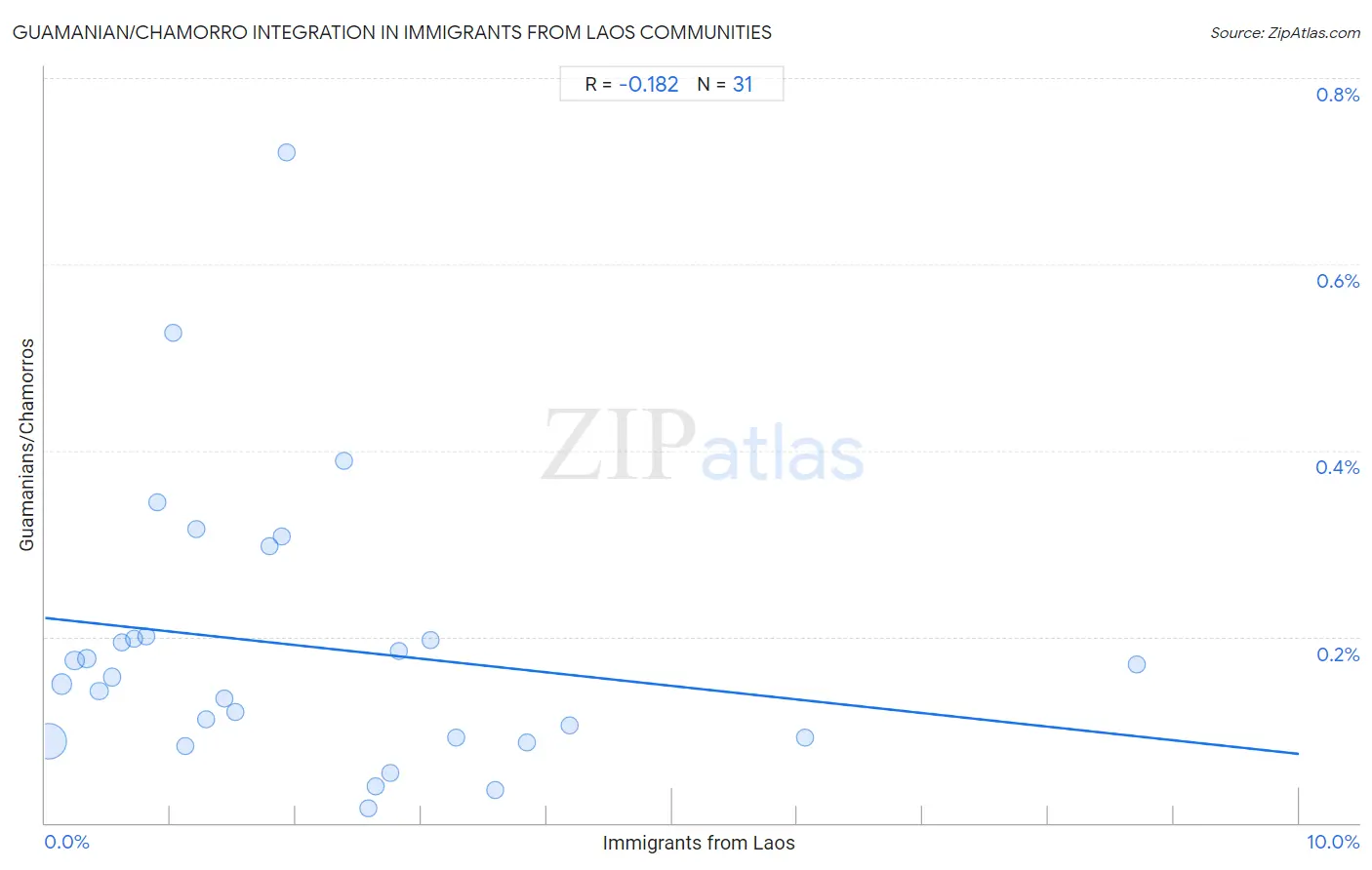
Immigrants from Laos vs Guamanian/Chamorro Income
When considering income, the most significant differences between Immigrants from Laos and Guamanian/Chamorro communities in the United States are seen in householder income over 65 years ($56,722 compared to $63,187, a difference of 11.4%), householder income ages 45 - 64 years ($90,909 compared to $101,170, a difference of 11.3%), and median household income ($78,327 compared to $86,255, a difference of 10.1%). Conversely, both communities are more comparable in terms of median female earnings ($36,841 compared to $38,717, a difference of 5.1%), householder income under 25 years ($50,041 compared to $53,423, a difference of 6.8%), and median earnings ($42,884 compared to $45,933, a difference of 7.1%).

| Income Metric | Immigrants from Laos | Guamanian/Chamorro |
| Per Capita Income | Tragic $37,857 | Tragic $41,678 |
| Median Family Income | Tragic $92,239 | Fair $101,061 |
| Median Household Income | Tragic $78,327 | Good $86,255 |
| Median Earnings | Tragic $42,884 | Fair $45,933 |
| Median Male Earnings | Tragic $49,190 | Fair $53,661 |
| Median Female Earnings | Tragic $36,841 | Poor $38,717 |
| Householder Age | Under 25 years | Tragic $50,041 | Exceptional $53,423 |
| Householder Age | 25 - 44 years | Tragic $85,553 | Fair $93,569 |
| Householder Age | 45 - 64 years | Tragic $90,909 | Good $101,170 |
| Householder Age | Over 65 years | Tragic $56,722 | Exceptional $63,187 |
| Wage/Income Gap | Exceptional 23.8% | Fair 26.0% |
Immigrants from Laos vs Guamanian/Chamorro Poverty
When considering poverty, the most significant differences between Immigrants from Laos and Guamanian/Chamorro communities in the United States are seen in child poverty among girls under 16 (18.9% compared to 15.9%, a difference of 18.4%), receiving food stamps (13.8% compared to 11.7%, a difference of 18.0%), and child poverty under the age of 5 (19.4% compared to 16.5%, a difference of 17.7%). Conversely, both communities are more comparable in terms of single father poverty (15.1% compared to 15.1%, a difference of 0.24%), seniors poverty over the age of 75 (12.0% compared to 11.6%, a difference of 2.9%), and single mother poverty (30.6% compared to 29.4%, a difference of 3.9%).
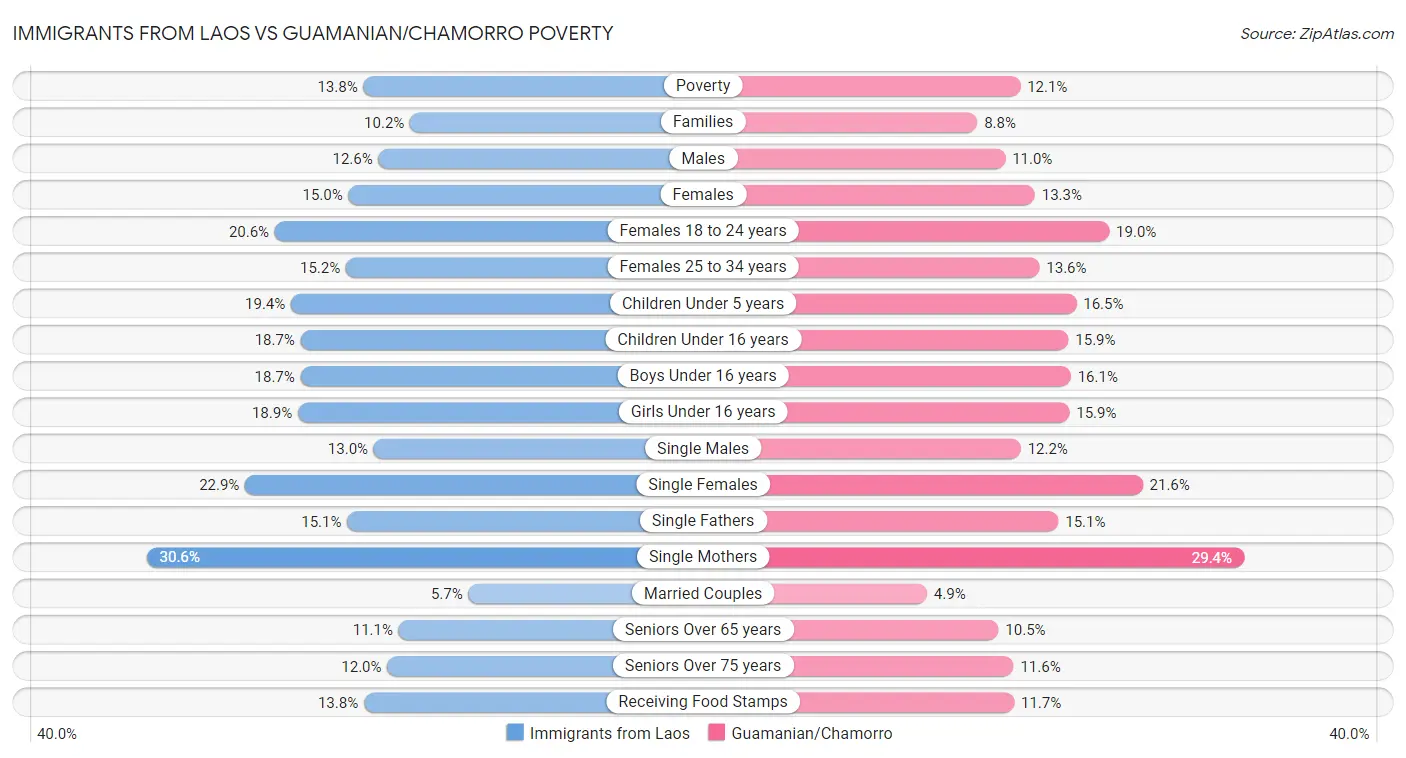
| Poverty Metric | Immigrants from Laos | Guamanian/Chamorro |
| Poverty | Tragic 13.8% | Good 12.1% |
| Families | Tragic 10.2% | Good 8.8% |
| Males | Tragic 12.6% | Good 11.0% |
| Females | Tragic 15.0% | Good 13.3% |
| Females 18 to 24 years | Tragic 20.6% | Exceptional 19.0% |
| Females 25 to 34 years | Tragic 15.2% | Average 13.6% |
| Children Under 5 years | Tragic 19.4% | Excellent 16.5% |
| Children Under 16 years | Tragic 18.7% | Good 15.9% |
| Boys Under 16 years | Tragic 18.7% | Good 16.1% |
| Girls Under 16 years | Tragic 18.9% | Good 15.9% |
| Single Males | Fair 13.0% | Exceptional 12.2% |
| Single Females | Tragic 22.9% | Poor 21.6% |
| Single Fathers | Exceptional 15.1% | Exceptional 15.1% |
| Single Mothers | Tragic 30.6% | Fair 29.4% |
| Married Couples | Tragic 5.7% | Excellent 4.9% |
| Seniors Over 65 years | Fair 11.1% | Excellent 10.5% |
| Seniors Over 75 years | Good 12.0% | Exceptional 11.6% |
| Receiving Food Stamps | Tragic 13.8% | Average 11.7% |
Immigrants from Laos vs Guamanian/Chamorro Unemployment
When considering unemployment, the most significant differences between Immigrants from Laos and Guamanian/Chamorro communities in the United States are seen in unemployment among women with children ages 6 to 17 years (8.2% compared to 9.1%, a difference of 11.0%), unemployment among ages 35 to 44 years (4.7% compared to 5.1%, a difference of 7.0%), and female unemployment (5.3% compared to 5.6%, a difference of 6.2%). Conversely, both communities are more comparable in terms of male unemployment (5.4% compared to 5.4%, a difference of 0.090%), unemployment among ages 65 to 74 years (5.3% compared to 5.4%, a difference of 1.4%), and unemployment among seniors over 65 years (5.1% compared to 5.2%, a difference of 1.5%).
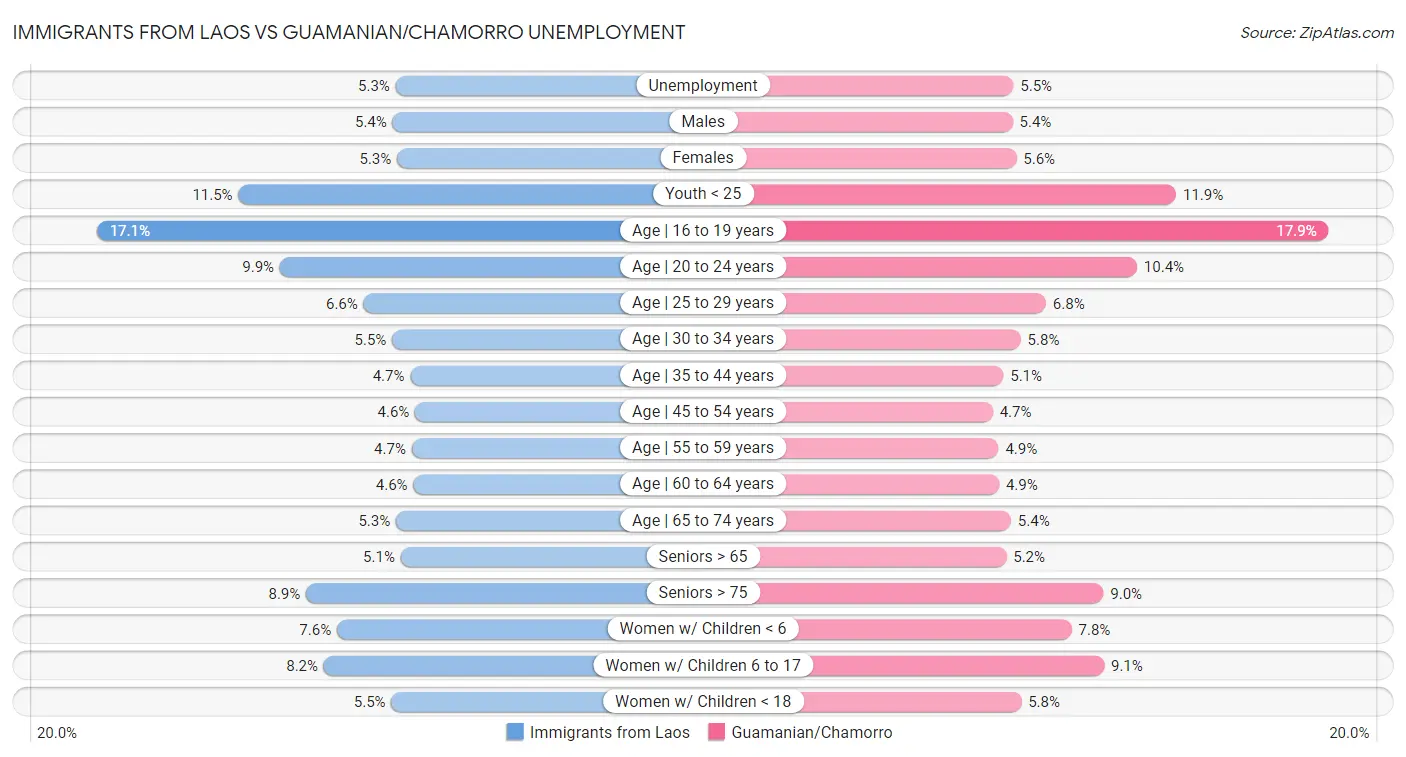
| Unemployment Metric | Immigrants from Laos | Guamanian/Chamorro |
| Unemployment | Fair 5.3% | Tragic 5.5% |
| Males | Poor 5.4% | Poor 5.4% |
| Females | Average 5.3% | Tragic 5.6% |
| Youth < 25 | Good 11.5% | Tragic 11.9% |
| Age | 16 to 19 years | Excellent 17.1% | Poor 17.9% |
| Age | 20 to 24 years | Exceptional 9.9% | Fair 10.4% |
| Age | 25 to 29 years | Good 6.6% | Fair 6.8% |
| Age | 30 to 34 years | Average 5.5% | Tragic 5.8% |
| Age | 35 to 44 years | Fair 4.7% | Tragic 5.1% |
| Age | 45 to 54 years | Fair 4.6% | Tragic 4.7% |
| Age | 55 to 59 years | Exceptional 4.7% | Fair 4.9% |
| Age | 60 to 64 years | Exceptional 4.6% | Fair 4.9% |
| Age | 65 to 74 years | Good 5.3% | Average 5.4% |
| Seniors > 65 | Good 5.1% | Fair 5.2% |
| Seniors > 75 | Fair 8.9% | Tragic 9.0% |
| Women w/ Children < 6 | Average 7.6% | Fair 7.8% |
| Women w/ Children 6 to 17 | Exceptional 8.2% | Fair 9.1% |
| Women w/ Children < 18 | Fair 5.5% | Tragic 5.8% |
Immigrants from Laos vs Guamanian/Chamorro Labor Participation
When considering labor participation, the most significant differences between Immigrants from Laos and Guamanian/Chamorro communities in the United States are seen in in labor force | age 16-19 (40.6% compared to 38.2%, a difference of 6.3%), in labor force | age 25-29 (84.8% compared to 83.9%, a difference of 1.0%), and in labor force | age 30-34 (84.2% compared to 83.5%, a difference of 0.84%). Conversely, both communities are more comparable in terms of in labor force | age 45-54 (81.6% compared to 81.6%, a difference of 0.050%), in labor force | age 20-64 (79.4% compared to 79.1%, a difference of 0.35%), and in labor force | age 35-44 (83.8% compared to 83.4%, a difference of 0.51%).

| Labor Participation Metric | Immigrants from Laos | Guamanian/Chamorro |
| In Labor Force | Age > 16 | Exceptional 66.0% | Exceptional 65.6% |
| In Labor Force | Age 20-64 | Fair 79.4% | Tragic 79.1% |
| In Labor Force | Age 16-19 | Exceptional 40.6% | Exceptional 38.2% |
| In Labor Force | Age 20-24 | Exceptional 77.4% | Exceptional 76.7% |
| In Labor Force | Age 25-29 | Good 84.8% | Tragic 83.9% |
| In Labor Force | Age 30-34 | Tragic 84.2% | Tragic 83.5% |
| In Labor Force | Age 35-44 | Tragic 83.8% | Tragic 83.4% |
| In Labor Force | Age 45-54 | Tragic 81.6% | Tragic 81.6% |
Immigrants from Laos vs Guamanian/Chamorro Family Structure
When considering family structure, the most significant differences between Immigrants from Laos and Guamanian/Chamorro communities in the United States are seen in single mother households (7.7% compared to 6.6%, a difference of 15.2%), single father households (2.9% compared to 2.6%, a difference of 10.9%), and births to unmarried women (34.0% compared to 31.6%, a difference of 7.5%). Conversely, both communities are more comparable in terms of family households with children (29.8% compared to 29.7%, a difference of 0.41%), divorced or separated (12.4% compared to 12.3%, a difference of 0.92%), and average family size (3.34 compared to 3.29, a difference of 1.4%).

| Family Structure Metric | Immigrants from Laos | Guamanian/Chamorro |
| Family Households | Exceptional 65.3% | Exceptional 66.6% |
| Family Households with Children | Exceptional 29.8% | Exceptional 29.7% |
| Married-couple Households | Tragic 45.1% | Exceptional 48.1% |
| Average Family Size | Exceptional 3.34 | Exceptional 3.29 |
| Single Father Households | Tragic 2.9% | Tragic 2.6% |
| Single Mother Households | Tragic 7.7% | Poor 6.6% |
| Currently Married | Tragic 45.0% | Good 47.1% |
| Divorced or Separated | Tragic 12.4% | Poor 12.3% |
| Births to Unmarried Women | Tragic 34.0% | Average 31.6% |
Immigrants from Laos vs Guamanian/Chamorro Vehicle Availability
When considering vehicle availability, the most significant differences between Immigrants from Laos and Guamanian/Chamorro communities in the United States are seen in 4 or more vehicles in household (7.7% compared to 8.1%, a difference of 4.6%), 3 or more vehicles in household (22.4% compared to 23.2%, a difference of 3.8%), and no vehicles in household (8.2% compared to 8.0%, a difference of 2.4%). Conversely, both communities are more comparable in terms of 1 or more vehicles in household (91.8% compared to 92.1%, a difference of 0.31%), 2 or more vehicles in household (59.2% compared to 60.5%, a difference of 2.2%), and no vehicles in household (8.2% compared to 8.0%, a difference of 2.4%).

| Vehicle Availability Metric | Immigrants from Laos | Guamanian/Chamorro |
| No Vehicles Available | Exceptional 8.2% | Exceptional 8.0% |
| 1+ Vehicles Available | Exceptional 91.8% | Exceptional 92.1% |
| 2+ Vehicles Available | Exceptional 59.2% | Exceptional 60.5% |
| 3+ Vehicles Available | Exceptional 22.4% | Exceptional 23.2% |
| 4+ Vehicles Available | Exceptional 7.7% | Exceptional 8.1% |
Immigrants from Laos vs Guamanian/Chamorro Education Level
When considering education level, the most significant differences between Immigrants from Laos and Guamanian/Chamorro communities in the United States are seen in no schooling completed (3.1% compared to 2.2%, a difference of 46.4%), professional degree (3.2% compared to 3.8%, a difference of 17.2%), and doctorate degree (1.4% compared to 1.6%, a difference of 17.1%). Conversely, both communities are more comparable in terms of kindergarten (96.9% compared to 97.9%, a difference of 1.1%), nursery school (96.9% compared to 97.9%, a difference of 1.1%), and 1st grade (96.8% compared to 97.8%, a difference of 1.1%).
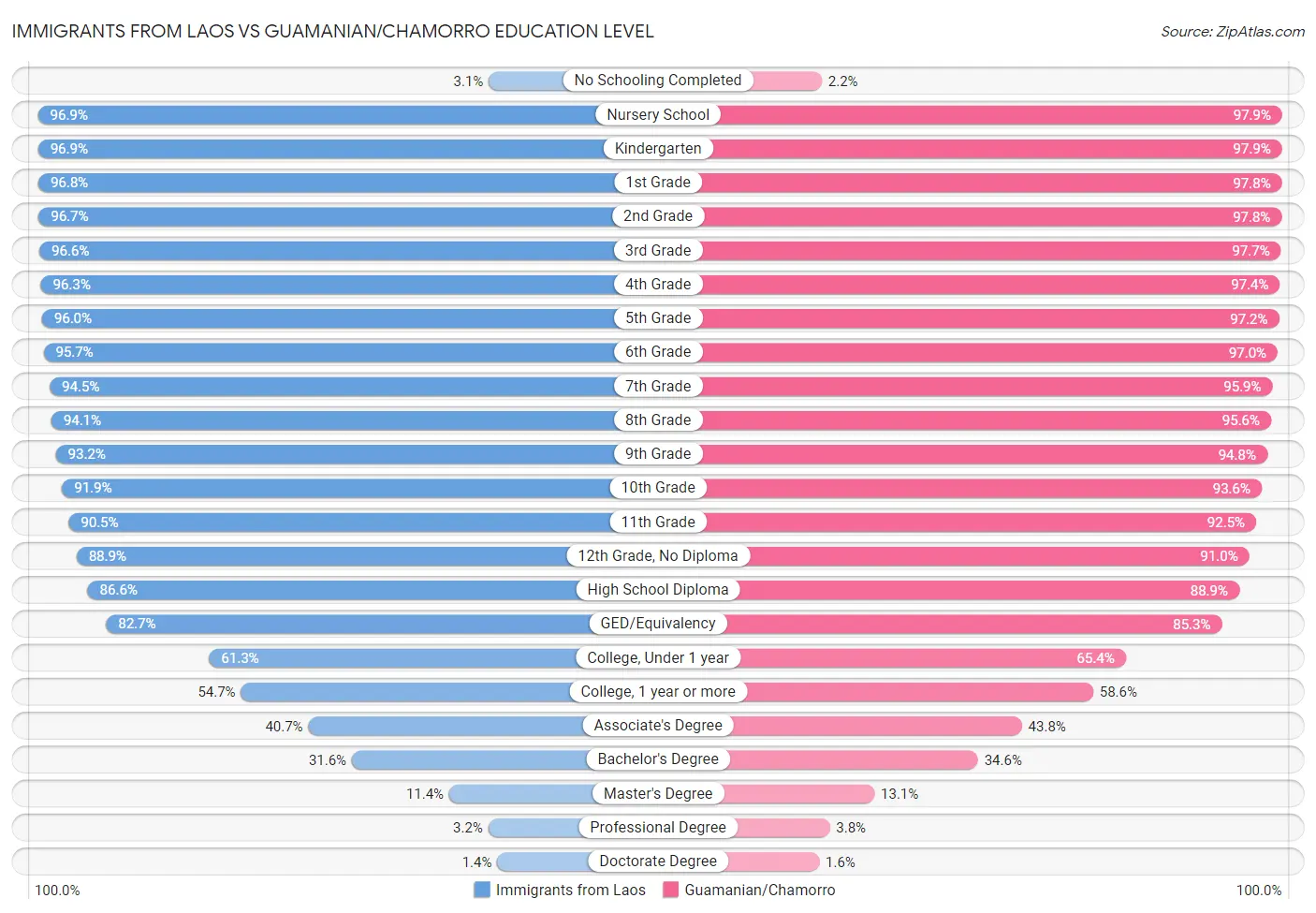
| Education Level Metric | Immigrants from Laos | Guamanian/Chamorro |
| No Schooling Completed | Tragic 3.1% | Fair 2.2% |
| Nursery School | Tragic 96.9% | Fair 97.9% |
| Kindergarten | Tragic 96.9% | Fair 97.9% |
| 1st Grade | Tragic 96.8% | Fair 97.8% |
| 2nd Grade | Tragic 96.7% | Fair 97.8% |
| 3rd Grade | Tragic 96.6% | Fair 97.7% |
| 4th Grade | Tragic 96.3% | Fair 97.4% |
| 5th Grade | Tragic 96.0% | Fair 97.2% |
| 6th Grade | Tragic 95.7% | Fair 97.0% |
| 7th Grade | Tragic 94.5% | Fair 95.9% |
| 8th Grade | Tragic 94.1% | Fair 95.6% |
| 9th Grade | Tragic 93.2% | Fair 94.8% |
| 10th Grade | Tragic 91.9% | Fair 93.6% |
| 11th Grade | Tragic 90.5% | Average 92.5% |
| 12th Grade, No Diploma | Tragic 88.9% | Fair 91.0% |
| High School Diploma | Tragic 86.6% | Fair 88.9% |
| GED/Equivalency | Tragic 82.7% | Fair 85.3% |
| College, Under 1 year | Tragic 61.3% | Average 65.4% |
| College, 1 year or more | Tragic 54.7% | Fair 58.6% |
| Associate's Degree | Tragic 40.7% | Tragic 43.8% |
| Bachelor's Degree | Tragic 31.6% | Tragic 34.6% |
| Master's Degree | Tragic 11.4% | Tragic 13.1% |
| Professional Degree | Tragic 3.2% | Tragic 3.8% |
| Doctorate Degree | Tragic 1.4% | Tragic 1.6% |
Immigrants from Laos vs Guamanian/Chamorro Disability
When considering disability, the most significant differences between Immigrants from Laos and Guamanian/Chamorro communities in the United States are seen in disability age 35 to 64 (13.0% compared to 12.2%, a difference of 6.0%), self-care disability (2.7% compared to 2.6%, a difference of 3.8%), and vision disability (2.4% compared to 2.3%, a difference of 3.4%). Conversely, both communities are more comparable in terms of ambulatory disability (6.3% compared to 6.3%, a difference of 0.33%), disability age over 75 (49.2% compared to 49.4%, a difference of 0.38%), and disability age 5 to 17 (5.8% compared to 5.8%, a difference of 0.49%).
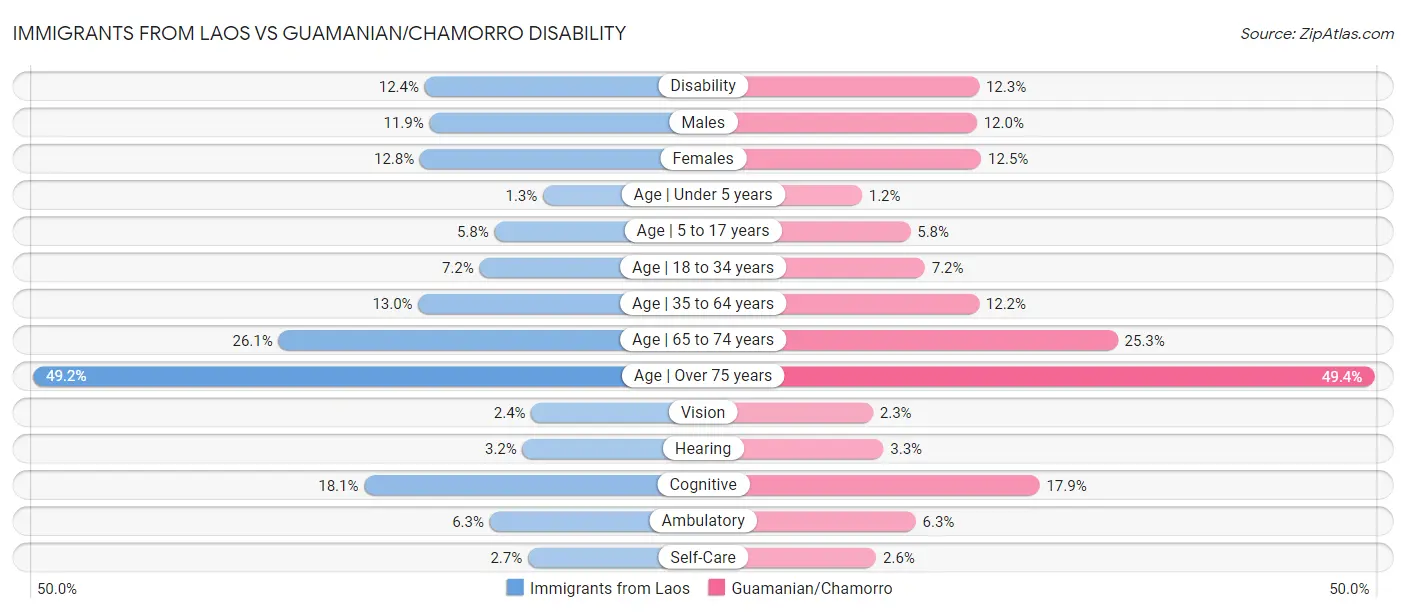
| Disability Metric | Immigrants from Laos | Guamanian/Chamorro |
| Disability | Tragic 12.4% | Tragic 12.3% |
| Males | Tragic 11.9% | Tragic 12.0% |
| Females | Tragic 12.8% | Tragic 12.5% |
| Age | Under 5 years | Fair 1.3% | Average 1.2% |
| Age | 5 to 17 years | Tragic 5.8% | Tragic 5.8% |
| Age | 18 to 34 years | Tragic 7.2% | Tragic 7.2% |
| Age | 35 to 64 years | Tragic 13.0% | Tragic 12.2% |
| Age | 65 to 74 years | Tragic 26.1% | Tragic 25.3% |
| Age | Over 75 years | Tragic 49.2% | Tragic 49.4% |
| Vision | Tragic 2.4% | Tragic 2.3% |
| Hearing | Tragic 3.2% | Tragic 3.3% |
| Cognitive | Tragic 18.1% | Tragic 17.9% |
| Ambulatory | Poor 6.3% | Poor 6.3% |
| Self-Care | Tragic 2.7% | Tragic 2.6% |